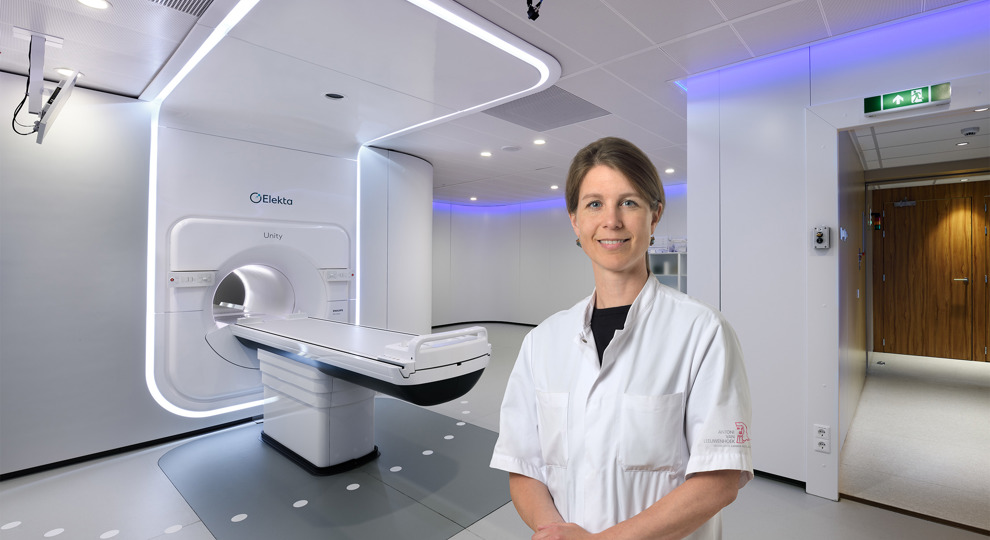Radiation Oncology
Radiotherapy, also known as radiation oncology, is a type of cancer treatment which uses radiation. There are two types of radiotherapy you can have: internal or external radiotherapy.
For external beam radiation, we use a radiation machine (linear accelerator) that aims at the area receiving treatment with great precision. The radiation can go deep into the body through the skin. For internal radiotherapy, the radiation will come from a source close to the tumor. This source will be placed into the body, or comes from small pellets that are implanted close to the tumor (brachytherapy). Read more about radiotherapy here.
The Netherlands Cancer Institute is a pioneer in image guided radiotherapy. We are happy to have been using the MR-linac for over a year now and use it to treat an increasing number of patients.

Staff at the Netherlands Cancer Institute develop new techniques and use the most advanced technology, like the MR-Linac, in imaging diagnostics, preparation before the radiation treatment, and the radiation treatment itself. This allows us to give you the most effective treatment possible while sparing healthy tissue as much as possible.
Click here for more information about our research into image guided therapy.
News
Our working methods
- During a consultation with one of our radiation oncologists you will have plenty of time to discuss your personal situation in order to find the best treatment for you. Other topics that you will discuss during this consultation are the goal of the treatment, the expected results, the preparations, the process, and any potential side effects you may experience.
- You will want to know what you can expect. This is why we will set up an information consultation for you, during which one of our information officers will tell you more about the preparations and how radiation treatment works.
- We are constantly working on new developments and improvements in radiotherapy. If you are eligible for participation in a trial, your radiation oncologist will ask you to consider enrolling. Participation is voluntary. If you decide not to enroll, you will receive your treatment according to the latest protocols and insights.
Our team
The medical specialists at our Radiation Oncology department are all radiation oncologists and Physician Assistants. Medical physicists ensure that new and existing medical equipment and techniques are applied safely and responsibly to optimize diagnostics and treatment for patients.
Our department and equipment
View a 360 degree image of one of our radiation rooms here:
MR-linac
As of 2018, the Radiation Oncology department has been using an MR-linac - a linear accelerator equipped with an MRI scanner. This allows us to visualize the area that requires radiation and adjust the radiation accordingly. This allows for greater precision and less damage to the surrounding healthy tissue. Precision means that we can deliver a higher dose of radiation so patients won’t have to come back as often for radiation sessions. The treatment is increasingly used for patients with prostate cancer, rectal cancer, and gland oligometastases. We continue to research the MR-Linac and are working to expand our application of the machine to treat patients with head and neck cancer, lung cancer, esophageal cancer, gynecological tumors, breast cancer, and liver metastases.
Linear accelerator
The radiation Oncology department has 10 linear accelerators available to use in cancer treatment. All machines are equipped with a cone beam CT scan to verify that the patient is positioned correctly. It can also calculate the radiation dose that has been delivered so we can be certain that we are delivering the correct dose to the correct area.
Gamma Knife
We have a Gamma Knife available to use in our treatment. This is a radiation machine that can deliver radiation to multiple brain tumors from various angles with great precision. This allows for a higher dose with a higher chance of controlling the illness, minimizing side effects and increasing quality of life.
Papillon
For internal radiation, we can use the radiation machine Papillon. This allows us to deliver radiation to small tumors in the rectum which can often replace surgery. The Netherlands Cancer Institute is the first hospital in the Netherlands that uses the Papillon in this way.
Branch location in Hoofddorp
Our second branch in Hoofddorp, near the Spaarne Gasthuis, offers the same high-quality treatment as in our Hospital in Amsterdam. We have two linear accelerators available at our branch, and all staff rotates between the two locations.
If you are receiving your treatment in Hoofddorp, you can find a description of the route to the Spaarne Gasthuis here.
 nl
nl
 Nederlands (Nederland)
Nederlands (Nederland)
 English (United States)
English (United States)

